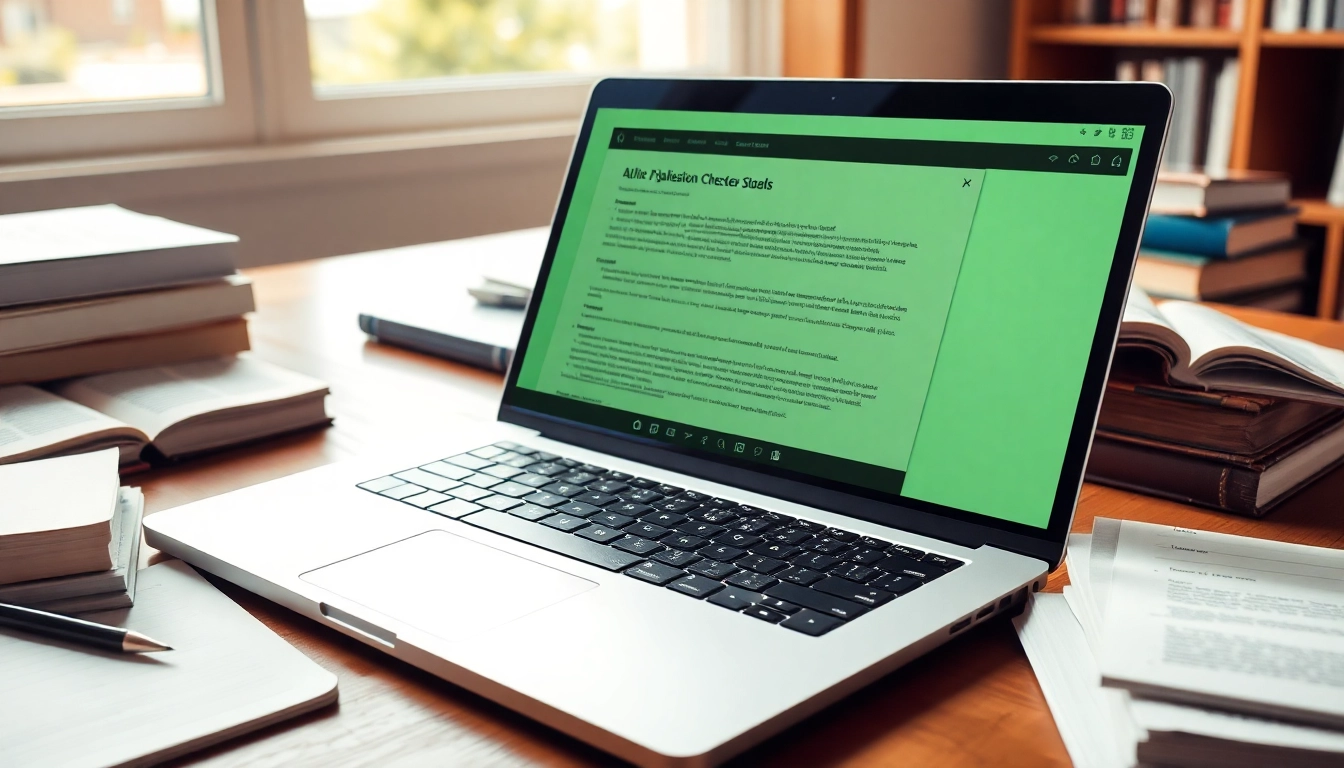Understanding Plagiarism and Its Consequences
What is Plagiarism?
Plagiarism is the act of using someone else’s work, ideas, or intellectual property and presenting it as one’s own. This unethical practice occurs across various fields, including academia, journalism, and digital content creation. It’s crucial to understand that plagiarism isn’t merely about copying text verbatim; it also encompasses ideas, imagery, and even data that have been borrowed or paraphrased without appropriate credit. In today’s interconnected world, where information is abundant and easily accessible, the boundaries of originality can sometimes blur, making awareness of what constitutes plagiarism more vital than ever.
Types of Plagiarism
Plagiarism can manifest in several forms, with each type carrying different implications and severity:
- Direct Plagiarism: This occurs when a person copies substantial sections of text word-for-word from a source without attribution.
- Self-Plagiarism: This happens when an author reuses their previously published work without acknowledgment. While it might seem harmless, it can mislead the audience regarding its novelty and originality.
- Paraphrasing Plagiarism: Even if the text is rewritten in one’s own words, failing to credit the original source can still be considered plagiarism, particularly if the rephrased content closely aligns with the source material.
- Mosaic Plagiarism: This involves mixing copied phrases with original ideas, leading to a form of patchwork content that doesn’t properly cite sources.
- Accidental Plagiarism: Not all plagiarism is intentional. Sometimes, individuals may unintentionally neglect to cite sources or misquote, but the consequences can still be severe.
Consequences of Plagiarism in Academia
The academic world takes plagiarism very seriously, and the repercussions can be dire. Some of the potential consequences include:
- Academic Sanctions: Students caught plagiarizing may face failing grades, suspension, or expulsion, depending on the severity of the offense.
- Loss of Reputation: Academic integrity is crucial. Plagiarism can tarnish an institution’s reputation and the student’s future prospects.
- Legal Repercussions: In severe cases, plagiarism may lead to legal action from the original authors or publishers.
- Impact on Learning: Relying on plagiarism undermines the learning process, limiting the development of critical thinking and writing skills necessary for academic and professional success.
How a Plagiarism Checker Works
Technology Behind Plagiarism Detection
Plagiarism checkers employ various advanced technologies to detect copied content across multiple platforms. These tools utilize algorithms that compare submitted texts against extensive databases containing books, websites, articles, and academic papers. The primary technologies include:
- Text Matching: Algorithms scan and match phrases and sentences from the submitted document against those in the database.
- Natural Language Processing (NLP): NLP techniques help in understanding the context of content and identifying paraphrased sections.
- Machine Learning: Over time, these tools improve their accuracy and efficiency in detecting variations in language use.
Common Features of Plagiarism Checkers
Plagiarism checkers offer a range of features designed to provide comprehensive text analysis, which can include:
- Multiple Source Checks: They compare documents against a vast array of online resources, including academic journals and websites.
- Similarity Reports: After analysis, users receive a detailed report highlighting sections of text that match other sources, often with links to the original content.
- Flagging Paraphrased Text: Advanced checkers can recognize rephrased content and suggest proper citations.
- Integration with Other Tools: Many checkers can integrate with writing platforms, enabling seamless usability.
Limitations of Automated Tools
While plagiarism checkers are invaluable, they are not infallible. Some limitations include:
- False Positives: Checkers may misidentify common phrases as plagiarized content or struggle with context, flagging original ideas as copied.
- Database Limitations: If a checker’s database is not extensive enough, it may fail to detect some sources.
- Nuanced Understanding: Automated tools may miss subtleties in language or ideas that a human reviewer might catch.
Choosing the Right Plagiarism Checker
Key Features to Look For
When selecting a plagiarism checker, consider the following critical features:
- Database Size: A comprehensive database increases the likelihood of detecting potential plagiarism.
- Accuracy: Look for user reviews and performance statistics that reflect the tool’s reliability in providing accurate plagiarism percentages.
- User-Friendly Interface: Choose a checker that is easy to navigate and quick in delivering results.
- Customer Support: Responsive customer service is crucial for troubleshooting issues and getting help with complex queries.
- Data Privacy: Ensure that your work will not be stored or used for any purpose without your consent.
Comparing Free vs. Paid Options
There are many plagiarism checkers available that range from free tools to premium services. Here’s how they typically compare:
- Free Tools: Generally offer basic features like text matching and basic reporting. They may come with limitations such as fewer database resources or restricted word counts.
- Paid Tools: Frequently provide more advanced features, including extensive checks against premium sources, advanced analytics, and additional writing tools. They may also offer higher accuracy and better customer support.
Ultimately, your choice should depend on the level of scrutiny you require—students might find basic tools sufficient, while academics or professionals may benefit from the depth of paid options.
Top Recommended Plagiarism Checkers
Here’s a breakdown of some of the most widely recognized plagiarism checkers available today:
- Grammarly Plagiarism Checker: Known for its user-friendly interface and integration with writing tools, Grammarly offers accurate plagiarism detection alongside grammar checking.
- PapersOwl: This tool combines an AI-powered plagiarism checker with options for easy citation and paraphrasing.
- Scribbr: Featured prominently in academic settings, Scribbr uses high-quality databases to ensure comprehensive checks.
- Copyscape: Popular for web content, Copyscape specializes in detecting duplicate online content, making it a favorite among bloggers and web authors.
Best Practices for Avoiding Plagiarism
Effective Research and Note-Taking Techniques
One of the leading causes of plagiarism is poor note-taking. Implementing effective habits can help mitigate this:
- Keep Detailed Bibliographies: Track all sources of information meticulously as you research.
- Use Quotation Marks: When documenting direct quotes, always use quotation marks and citations to denote the source clearly.
- Summarize and Paraphrase Properly: Ensure you understand the material before rewording, and still give credit to the original idea.
Proper Citation Methods
Acknowledging the work of others through citations is essential in maintaining academic integrity. Familiarize yourself with different citation styles, such as:
- APA: Commonly used in psychological and social sciences.
- MLA: Preferred in humanities and liberal arts.
- Chicago: Often used in history and some social sciences.
Understanding these styles will ensure that you can properly attribute sources, thereby reducing the risk of unintentional plagiarism.
Utilizing Paraphrasing Tools Alongside Checkers
Paraphrasing tools can assist in rewriting content and help achieve originality. However, it’s crucial to use them judiciously:
Mix your style and perspective when using these tools, so the output reflects your unique voice. Combining them with a reliable plagiarism checker can confirm the originality of your revisions.
Evaluating the Performance of Your Plagiarism Checker
Understanding Plagiarism Reports
After running a plagiarism check, reading and interpreting the report thoroughly is crucial. Most plagiarism checkers will highlight matches with the source material and provide percentage scores indicating the level of similarity.
Learn to interpret these reports properly—sometimes, a high percentage does not necessarily mean wrongdoing. Assess the context, distinguishing between common phrases and significant ideas borrowed from others.
Improving Your Writing with Feedback
Utilizing plagiarism checkers is not only about avoiding plagiarism; it can also enhance your writing skills. Use the suggestions and highlighted areas as learning opportunities:
- Identify Patterns: Analyze the types of content that were flagged to understand your writing style’s tendencies.
- Refinement: Implement feedback to improve your writing clarity, coherence, and style.
Continuous Learning and Staying Updated
The landscape of plagiarism detection is constantly evolving. It’s important to stay informed about:
- Updates on Plagiarism Policies: Academic institutions frequently update their integrity policies, so ensure that you are aware of the latest guidelines.
- Technological Advances: Follow the latest developments in plagiarism detection technology and understand how new features may help enhance your writing process.
- Writing Best Practices: Regularly engage in writing workshops and courses that emphasize original content creation and ethical research practices.



